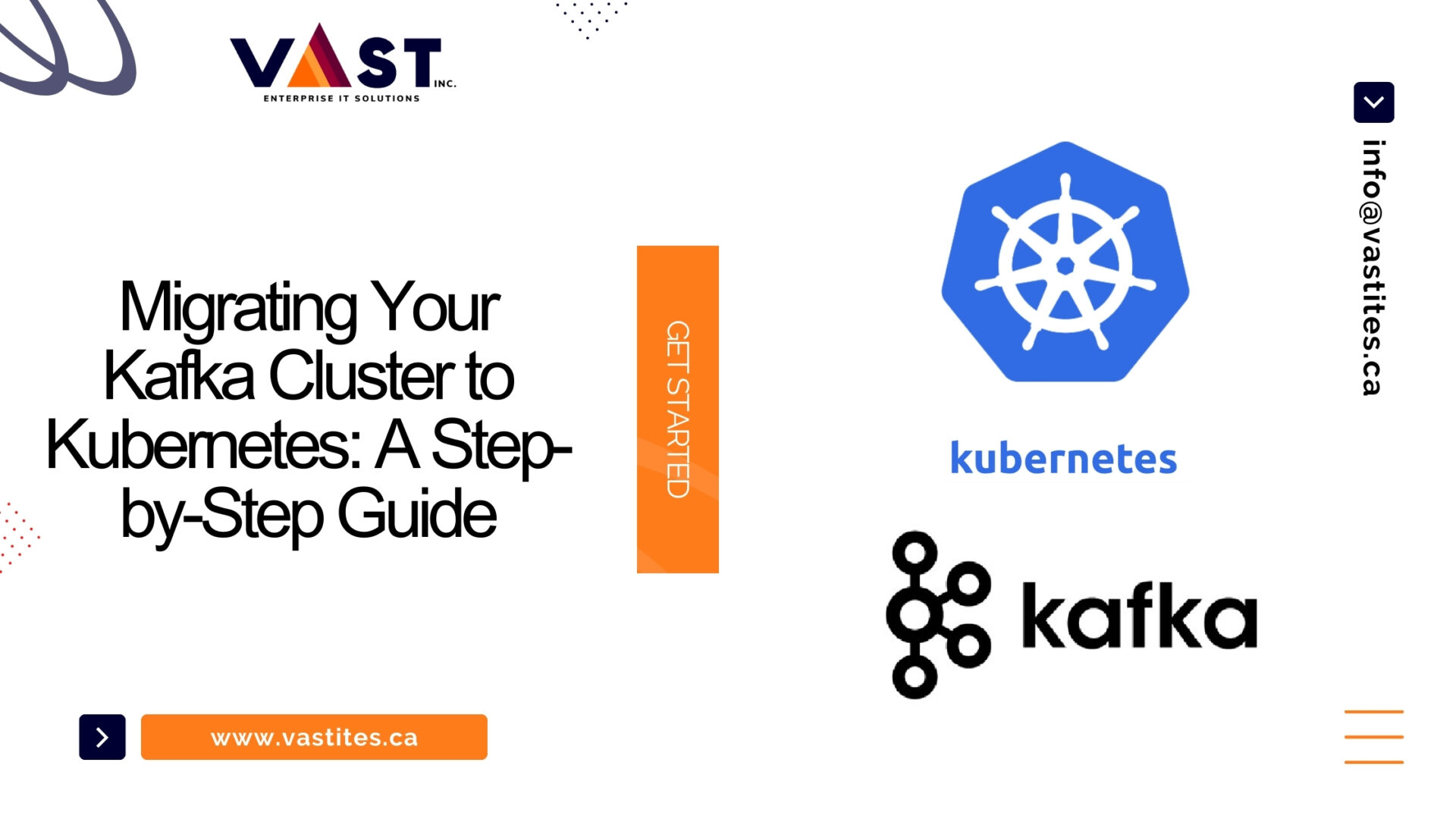
Introduction
Kafka and Kubernetes are two powerful technologies that, when combined, can bring significant benefits to your data infrastructure. In this step-by-step guide, we will explore the process of migrating a Kafka cluster to Kubernetes, providing you with the knowledge and tools necessary to successfully make the transition.
Brief Explanation of Kafka and Kubernetes
Kafka is a distributed streaming platform that allows you to build scalable, fault-tolerant, and real-time data pipelines. It provides a unified platform for handling high-volume, high-throughput data streams, making it an essential component in many modern data architectures.
On the other hand, Kubernetes is an open-source container orchestration platform that automates the deployment, scaling, and management of containerized applications. It simplifies the management of complex applications by providing a flexible and scalable infrastructure.
Importance of Migrating a Kafka Cluster to Kubernetes
Migrating your Kafka cluster to Kubernetes offers several advantages:
- Scalability: Kubernetes allows you to easily scale your Kafka cluster by adding or removing nodes as needed.
- Flexibility: With Kubernetes, you can deploy Kafka alongside other services in a containerized environment, enabling efficient resource utilization and easier integration with other systems.
- Fault-tolerance: Kubernetes ensures high availability by automatically restarting failed Kafka instances and distributing them across multiple nodes.
- Simplified Operations: Managing your Kafka cluster on Kubernetes simplifies operational tasks such as provisioning resources, monitoring performance, and handling upgrades.
Key Benefits of Managing Kafka on Kubernetes
- Improved Automation: Kubernetes provides advanced automation capabilities for managing kafka clusters, reducing manual intervention and enabling streamlined operations.
- Reduced Operational Overheads: By leveraging Kubernetes’ orchestration capabilities, you can minimize the effort required to manage infrastructure resources and handle maintenance tasks.
- Increased Development Focus: With the infrastructure management taken care of by Kubernetes, your development teams can focus more on building and enhancing the Kafka-based applications.
In the following sections, we will dive into the migration process, exploring different techniques and considerations for a successful transition. So let’s get started with understanding the migration process in detail! Read More: What is Kubernetes for Beginners? Features of Kubernetes
Understanding the Migration Process
Unidirectional Cluster-to-Cluster Migration Using MirrorMaker2
One approach to migrating a Kafka cluster from VM-based infrastructure to Kubernetes-based infrastructure is through unidirectional cluster-to-cluster migration using MirrorMaker2. This method involves setting up a new Kafka cluster on Kubernetes and gradually replicating data and configuration from the old cluster to the new one.
The following steps outline the migration process:
Set up the new Kafka cluster:
Deploy a new Kafka cluster on Kubernetes, ensuring that it is properly configured and ready to receive data from the old cluster.
Configure MirrorMaker2:
MirrorMaker2 is a Kafka tool that facilitates data replication between clusters. Configure MirrorMaker2 to replicate data from the old cluster to the new one. This can be done by specifying the source and destination clusters, topics to be replicated, and any necessary transformations.
Start the replication:
Once MirrorMaker2 is properly configured, start the replication process. MirrorMaker2 will continuously consume messages from the source cluster and produce them to the destination cluster.
Monitor and validate:
Monitor the replication process to ensure that it is progressing as expected. Use Kafka monitoring tools like Burrow or Confluent Control Center to track metrics such as lag and throughput. Validate that data is being replicated accurately by comparing message counts and content between the old and new clusters.
Transition clients:
Gradually redirect your clients to consume from the new Kafka cluster instead of the old one. This can be done by updating client configurations or DNS records, ensuring a smooth transition without interrupting data ingestion or consumption.
Complete migration:
Once all clients have been successfully transitioned to the new cluster and replication is complete, decommission the old Kafka cluster running on VM-based infrastructure
By following these steps, you can migrate your Kafka cluster from VM-based infrastructure to Kubernetes-based infrastructure using unidirectional cluster-to-cluster migration with MirrorMaker2. This approach allows for a gradual and controlled migration process, ensuring minimal disruption to your data pipelines.
During the migration process, it is important to replicate both the configuration and data from the old cluster to the new one:
- Configuration includes topics, partitions, consumer groups, and any other relevant Kafka settings.
- Data replication ensures that all messages are transferred from the old cluster to the new one, maintaining data integrity and consistency.
Overall, unidirectional cluster-to-cluster migration using MirrorMaker2 provides a reliable and efficient method for migrating Kafka clusters to Kubernetes-based infrastructure. It allows for a seamless transition while minimizing downtime and ensuring operational continuity. Read More: Kubernetes in Azure: Exploring Azure Kubernetes Services
Broker-Level Migration within a Consolidated Kafka Cluster
In the process of migrating a Kafka cluster from VM-based infrastructure to a Kubernetes-based one, broker-level migration plays a crucial role in ensuring a seamless transition. This section delves into the complexities and nuances of this migration approach, shedding light on the network setup, implementation, monitoring, and mitigation strategies.
Detailed Explanation of Broker-Level Migration
Broker-level migration involves transitioning individual Kafka brokers from the existing VM-based infrastructure to the new Kubernetes-based infrastructure. This entails meticulous planning to minimize disruption, maintain data integrity, and uphold operational continuity. Unlike unidirectional cluster-to-cluster migration using MirrorMaker2, broker-level migration operates within a consolidated Kafka cluster.
Network Setup for the Migration Process
The migration necessitates a robust network setup to facilitate the seamless transfer of data and ensure minimal latency during the transition. It involves configuring network policies, load balancers, and inter-broker communication channels to enable secure and efficient data replication across the clusters.
Implementation and Orchestration of the Migration
Implementing broker-level migration demands meticulous coordination and orchestration to prevent inconsistencies and data loss. This involves mapping out a phased approach for migrating individual brokers while closely monitoring their performance and ensuring synchronized data replication between the old and new environments.
Metrics and Monitoring During the Migration
Comprehensive metrics and real-time monitoring are indispensable during the migration process. Leveraging Kubernetes-native monitoring tools allows for continuous assessment of resource utilization, throughput, latency, and error rates across both environments. These insights are pivotal in identifying anomalies and optimizing performance throughout the migration.
Managing Broker Disruption During the Migration
Minimizing disruption to Kafka brokers is paramount to preserving operational continuity. Employing rolling updates, graceful leader transitions, and fault-tolerant deployment strategies help mitigate potential disruptions while ensuring that clients seamlessly transition to the new Kubernetes-based infrastructure without service interruptions.
By navigating through each facet of broker-level migration within a consolidated Kafka cluster, organizations can effectively mitigate challenges associated with infrastructure transitions while maintaining optimal performance and reliability throughout the migration process.
Zookeeper Cluster Migration to Kraft Controller
When migrating a Kafka cluster from VM-based infrastructure to a Kubernetes-based one, the process involves various critical components, including the migration of the Zookeeper cluster to Kraft controller. This section will delve into the importance of this migration and the steps involved in the process.
Inclusion of Zookeeper Cluster Migration
As part of the overall Kafka cluster migration, it’s essential to consider the migration of the Zookeeper cluster to Kraft controller. The Zookeeper ensemble is a fundamental component of Kafka that manages various tasks such as leader election, configuration management, and synchronization. Migrating it to Kraft controller ensures seamless integration with the Kubernetes-based infrastructure and further optimizes the operational aspects of managing Kafka clusters.
Importance of Migrating the Zookeeper Cluster to Kraft Controller
Migrating the Zookeeper cluster to Kraft controller holds significant importance in ensuring the robustness and reliability of the overall Kafka infrastructure on Kubernetes. By transitioning to Kraft controller, you can leverage its enhanced capabilities for managing stateful applications within a Kubernetes environment. This not only streamlines operational processes but also aligns with best practices for running distributed systems in Kubernetes.
Steps Involved in Migrating the Zookeeper Cluster
The migration process entails several key steps to ensure a smooth transition of the Zookeeper cluster to Kraft controller:
- Assessment and Pre-migration Planning: Evaluate the existing Zookeeper cluster setup and plan for the migration, considering factors such as data synchronization, network configurations, and potential downtime.
- Backup and Data Replication: Create backups of Zookeeper data and establish mechanisms for replicating data to ensure data integrity during and after the migration.
- Deployment in Kubernetes: Set up a new instance of Kraft controller within your Kubernetes environment, configuring it to integrate seamlessly with other components of your Kafka infrastructure.
- Data Migration and Synchronization: Initiate the process of migrating data from the existing Zookeeper cluster to Kraft controller while ensuring continuous synchronization to prevent data inconsistencies.
- Testing and Validation: Thoroughly test the functionality of the migrated Zookeeper cluster within Kubernetes, validating its performance and resilience under varying conditions.
- Final Cutover and Decommissioning: Once validated, execute the final cutover from the old Zookeeper cluster to Kraft controller, followed by decommissioning activities for the legacy setup.
By following these steps diligently, you can effectively migrate your Zookeeper cluster to Kraft controller while mitigating potential disruptions and ensuring a seamless transition within your Kafka ecosystem on Kubernetes.
Benefits of Managing Kafka on Kubernetes
Managing Kafka on Kubernetes offers a range of benefits, making it an attractive option for organizations looking to streamline their data infrastructure. Here are some key advantages:
Improved automation in managing Kafka clusters
Kubernetes provides robust automation capabilities, allowing for easier management of Kafka clusters. With features such as auto-scaling and self-healing, Kubernetes minimizes the need for manual intervention, leading to greater operational efficiency.
Reduced operational overheads with Kubernetes-based infrastructure
By leveraging Kubernetes for Kafka cluster management, organizations can significantly reduce operational complexities and associated costs. The streamlined infrastructure orchestration and management capabilities of Kubernetes help optimize resource utilization and minimize administrative burdens.
Increased development focus with Kubernetes-based deployment
With Kubernetes handling the heavy lifting of infrastructure management, development teams can shift their focus towards building and optimizing applications. This leads to faster development cycles and enhanced innovation, ultimately driving business growth.
In summary, managing Kafka on Kubernetes brings about improved automation, reduced operational overheads, and a sharper focus on development efforts, making it a compelling choice for modernizing data operations. Read More: Decoding Kubernetes and Docker
Conclusion
Migrating your Kafka cluster to Kubernetes offers numerous benefits and is a crucial step towards modernizing your infrastructure. By leveraging the power of Kubernetes, you can enhance the scalability, reliability, and manageability of your Kafka clusters.
The step-by-step guide provided in this article offers a comprehensive approach to migrate your Kafka cluster seamlessly. It covers different migration designs such as unidirectional cluster-to-cluster migration using MirrorMaker2 and broker-level migration within a consolidated Kafka cluster.
By following this guide, you can ensure a successful migration process while minimizing disruptions and maintaining operational continuity. The guide includes detailed explanations of each step involved in the migration process, such as replicating configuration and data from the old cluster to the new one.
Benefits of Migrating Your Kafka Cluster to Kubernetes
By migrating your Kafka cluster to Kubernetes, you can:
- Improve automation in managing Kafka clusters
- Reduce operational overheads with Kubernetes-based infrastructure
- Increase development focus with Kubernetes-based deployment
Embracing these benefits will empower your team to deliver high-performance and scalable Kafka solutions.
Therefore, I strongly encourage you to implement this step-by-step guide for migrating your Kafka cluster to Kubernetes. By doing so, you will unlock the full potential of Kubernetes and ensure a smooth transition that enhances your Kafka infrastructure.
Migrate your Kafka cluster to Kubernetes today and embrace the future of scalable and efficient data streaming!
Best DevOps Consulting in Toronto – VaST ITES Inc
